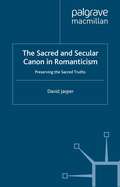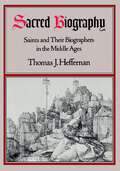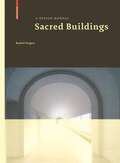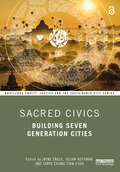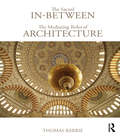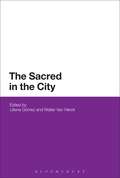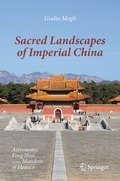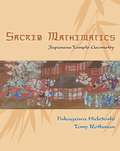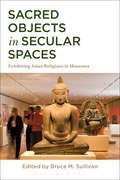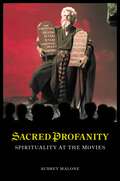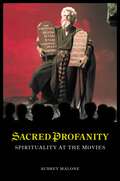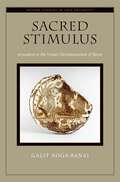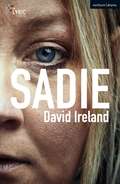- Table View
- List View
The Sacred and Secular Canon in Romanticism: Preserving the Sacred Truths (Romanticism in Perspective:Texts, Cultures, Histories)
by D. JasperThis book is an interdisciplinary study of Romanticism which focuses on the reception of the Biblical canon in poetry, art and theory. The Bible is acknowledged as the heart of European culture, but as its status as the sacred text of Judaism and Christianity becomes questionable, it remains at the turning-point between sacred and secular art in the modern world. The insights of Romanticism are crucial for our understanding of postmodernism as a fundamentally religious movement which acknowledges both the death and rebirth of religious language.
The Sacred and the Cinema: Reconfiguring the 'Genuinely' Religious Film
by Sheila J. NayarFor more than half a centurynow, scholars have debated over what comprises a 'genuinely' religious film-onethat evinces an 'authentic' manifestation of the sacred. Often these scholarsdo so by pitting the 'successful' films against those which propagate aninauthentic spiritual experience-with the biblical spectacular serving as theirmost notorious candidate. This book argues that whatmakes a filmic manifestation of the sacred true or authentic may say moreabout a spectator or critic's particular way of knowing, as influenced byalphabetic literacy, than it does about the aesthetic or philosophical-andsometimes even faith-based-dimensions of the sacred onscreen. Engaging witheverything from Hollywood religious spectaculars, Hindu mythologicals, and aninternational array of films revered for their 'transcendental style,' The Sacred and the Cinema unveils theepistemic pressures at the heart of engaging with the sacred onscreen. The bookalso provides a valuable summation of the history of the sacred as a field ofstudy, particularly as that field intersects with film.
The Sacred and the Cinema: Reconfiguring the 'Genuinely' Religious Film
by Sheila J. NayarFor more than half a centurynow, scholars have debated over what comprises a 'genuinely' religious film-onethat evinces an 'authentic' manifestation of the sacred. Often these scholarsdo so by pitting the 'successful' films against those which propagate aninauthentic spiritual experience-with the biblical spectacular serving as theirmost notorious candidate. This book argues that whatmakes a filmic manifestation of the sacred true or authentic may say moreabout a spectator or critic's particular way of knowing, as influenced byalphabetic literacy, than it does about the aesthetic or philosophical-andsometimes even faith-based-dimensions of the sacred onscreen. Engaging witheverything from Hollywood religious spectaculars, Hindu mythologicals, and aninternational array of films revered for their 'transcendental style,' The Sacred and the Cinema unveils theepistemic pressures at the heart of engaging with the sacred onscreen. The bookalso provides a valuable summation of the history of the sacred as a field ofstudy, particularly as that field intersects with film.
The Sacred and the Feminine: Imagination and Sexual Difference (New Encounters: Arts, Cultures, Concepts)
by Griselda Pollock Victoria Turvey-SauronThe notion of a special intimacy between 'the feminine and the sacred' has received significant attention since the publication of Julia Kristeva and Cathérine Clément's famous ecumenical 'conversation' of the same name which focussed on the relationship between meaning and the body at whose interface the feminine is positioned. Brought to the wider public as the 'sacred feminine', it has also made its mark on popular culture. Taking up the debate and moving beyond anthropology or theology, writers from varied ethnic, geo-cultural and religious perspectives here join with secular cultural analysts to explore the sacred and the feminine in art, architecture, literature, art history, music, philosophy, theology, critical theory and cultural studies. The book addresses key issues in feminist questions of creativity, the imaginary and the sacred as 'otherness', exploring the ways in which visual practices have explored this rich, contested and highly charged territory.
Sacred Architecture in a Secular Age: Anamnesis of Durham Cathedral (Routledge Research in Architecture)
by Marie ClausénHaving won more than one recent poll as Britain’s best-loved building, the appeal of Durham Cathedral appears abiding, which begs the question whether an iconic sacred building can retain meaning and affective pertinence for contemporary, secular visitors. Using the example of Durham Cathedral, this book sets out to explore wherein the appeal of historic churches lies today and considers questions of how and why their preservation into a post-Christian era should be secured. By including feedback from visitors to the cathedral, and the author’s own very personal account of the cathedral in the form of an ekphrasis, this work seeks to privilege an interpretation of architecture that is based on the individual experience rather than on more conventional narratives of architecture history and cultural heritage policy. Recognising the implication of our choice of narrative on the perceived value of historic churches is crucial when deliberating their future role. This book puts forth a compelling case for historical sacred architecture, suggesting that its loss - through imperceptive conservation practices as much as through neglect or demolition - would diminish us all, secularists, atheists and agnostics included.
Sacred Architecture in a Secular Age: Anamnesis of Durham Cathedral (Routledge Research in Architecture)
by Marie ClausénHaving won more than one recent poll as Britain’s best-loved building, the appeal of Durham Cathedral appears abiding, which begs the question whether an iconic sacred building can retain meaning and affective pertinence for contemporary, secular visitors. Using the example of Durham Cathedral, this book sets out to explore wherein the appeal of historic churches lies today and considers questions of how and why their preservation into a post-Christian era should be secured. By including feedback from visitors to the cathedral, and the author’s own very personal account of the cathedral in the form of an ekphrasis, this work seeks to privilege an interpretation of architecture that is based on the individual experience rather than on more conventional narratives of architecture history and cultural heritage policy. Recognising the implication of our choice of narrative on the perceived value of historic churches is crucial when deliberating their future role. This book puts forth a compelling case for historical sacred architecture, suggesting that its loss - through imperceptive conservation practices as much as through neglect or demolition - would diminish us all, secularists, atheists and agnostics included.
Sacred Art
by Kathleen HoffmanA creative toolbox of techniques and ideas to take your painting to a new spiritual dimension.All of nature is permeated by a hidden geometric creative power. From the spiral growth of ferns, fractal branching systems in trees, and symmetries in leaves and flowers: everything in nature is connected and follows universal principles.In this exquisite book, artist Kathleen Hoffman shares her fascination with mandalas, sacred symbols such as the triskelion and the labyrinth, and nature's endless wonder, through a collection of 12 step-by-step painting projects, accessible to painters of all abilities. Hoffman begins with the basic techniques of acrylic painting and then builds on this with each project, showing new design elements that are used in her pictures and how she implements them in terms of colour and composition.This book is an invitation to connect with the power of nature and symbols; to discover the infinite variety of these structures, and to unfold this beauty in your painting.
Sacred Biography: Saints and Their Biographers in the Middle Ages
by Thomas J. HeffernanThough medieval "saints' lives" are among the oldest literary texts of Western vernacular culture, they are routinely patronized as "pious fiction" by modern historiography. This book demonstrates that to characterize the genre as fiction is to misunderstand the intentions of medieval authors, who were neither credulous fools nor men blinded by piety. Concentrating on English texts, Heffernan reconstructs the medieval perspective and considers sacred biography in relation to the community for which it was written; identifies the genre's rhetorical practices and purposes; and demonstrates the syncretistic way in which the life of the medieval saint was transformed from oral tales to sacred text. In the process, Heffernan not only achieves a more contextually accurate understanding of the medieval saints' lives, but details a new critical method that has important implications for the practice of textual criticism.
Sacred Buildings: A Design Manual (Design Manuals)
by Rudolf Stegers10 ChurchArchitecture PastandPresent RudolfStegers Faith and Religion in the Present Day / Historicismversus Modernity /The Church in the City / EcclesiasticArchitecture from the athto the 19th Century /The Development of Modern Church Architecture / At the Beginning ofthe zist Century /The Sacred and its Relevance for Church Architecture Today 38 SynagogueArchitectureinthe Recent PastandPresent Roman HoHenstein Synagogue Architecture in the zoth Century / Pioneering New Buildings from Louis Kahn to Mario Botta /The Design of the Synagogue Space /ATheory of Synagogue Design / Architectonic Symbols in Germany /Tradition over Experimentation in the United States 46 MosqueArchitecture PastandPresent NegarHakim The Formation and Expansion of Islam / The Mosque as the Centre of Religious Life / The Four Types of Mosques / zoth-Century Mosque Architecture in the Islamic World / 20th-Century Mosque Architecture in the Nations ofthe Diaspora /The Spatial Programme and Arrangement of Modern-DayMosques 54 Acousticsin SacredBuildings Dorothea BaumannandChristina Niederstatter The Sound of Space as a Symbol ofthe Sacred /Architectural Acoustics - The Conflict between Resonance and Clarity / Sound and Sound Propagation / Geometric Analysis / Reflection and Diffraction / Reverberation Time and Absorption / The Number ofPeople / Materials / Special Aspects of Acoustics in Sacred Spaces /Acoustic Analysis 60 Lightin SacredBuildings Eva-Maria Kreuz Light in Churches / Light in Synagogues / Light in Mosques Selection ofProjects CHURCHES AXIAL PLAN CENTRALISE D PLAN 100 146 TornbjergChurch Paper Church Odense Kobe 70 118 Fogh & FolnerArkitektfirma Shigeru Ban Architects Church Centre Church of Our Lady of Lourdes
Sacred Civics: Building Seven Generation Cities (Routledge Equity, Justice and the Sustainable City series)
by Jayne EngleSacred Civics argues that societal transformation requires that spirituality and sacred values are essential to reimagining patterns of how we live, organize and govern ourselves, determine and distribute wealth, inhabit and design cities, and construct relationships with others and with nature. The book brings together transdisciplinary and global academics, professionals, and activists from a range of backgrounds to question assumptions that are fused deep into the code of how societies operate, and to draw on extraordinary wisdom from ancient Indigenous traditions; to social and political movements like Black Lives Matter, the commons, and wellbeing economies; to technologies for participatory futures where people collaborate to reimagine and change culture. Looking at cities and human settlements as the sites of transformation, the book focuses on values, commons, and wisdom to demonstrate that how we choose to live together, to recognize interdependencies, to build, grow, create, and love—matters. Using multiple methodologies to integrate varied knowledge forms and practices, this truly ground-breaking volume includes contributions from renowned and rising voices. Sacred Civics is a must-read for anyone interested in intersectional discussions on social justice, inclusivity, participatory design, healthy communities, and future cities.
Sacred Civics: Building Seven Generation Cities (Routledge Equity, Justice and the Sustainable City series)
by Jayne Engle Julian Agyeman Tanya Chung-Tiam-FookSacred Civics argues that societal transformation requires that spirituality and sacred values are essential to reimagining patterns of how we live, organize and govern ourselves, determine and distribute wealth, inhabit and design cities, and construct relationships with others and with nature. The book brings together transdisciplinary and global academics, professionals, and activists from a range of backgrounds to question assumptions that are fused deep into the code of how societies operate, and to draw on extraordinary wisdom from ancient Indigenous traditions; to social and political movements like Black Lives Matter, the commons, and wellbeing economies; to technologies for participatory futures where people collaborate to reimagine and change culture. Looking at cities and human settlements as the sites of transformation, the book focuses on values, commons, and wisdom to demonstrate that how we choose to live together, to recognize interdependencies, to build, grow, create, and love—matters. Using multiple methodologies to integrate varied knowledge forms and practices, this truly ground-breaking volume includes contributions from renowned and rising voices. Sacred Civics is a must-read for anyone interested in intersectional discussions on social justice, inclusivity, participatory design, healthy communities, and future cities.
The Sacred In-Between: The Mediating Roles of Architecture
by Thomas BarrieThe sacred place was, and still is, an intermediate zone created in the belief that it has the ability to co-join the religious aspirants to their gods. An essential means of understanding this sacred architecture is through the recognition of its role as an ‘in-between’ place. Establishing the contexts, approaches and understandings of architecture through the lens of the mediating roles often performed by sacred architecture, this book offers the reader an extraordinary insight into the forces behind these extraordinary buildings. Written by a well-known expert in the field, the book draws on a unique range of cases, reflecting on these inspiring places, their continuing ontological significance and the lessons they can offer today. Fascinating reading for anyone interested in sacred architecture.
The Sacred In-Between: The Mediating Roles of Architecture
by Thomas BarrieThe sacred place was, and still is, an intermediate zone created in the belief that it has the ability to co-join the religious aspirants to their gods. An essential means of understanding this sacred architecture is through the recognition of its role as an ‘in-between’ place. Establishing the contexts, approaches and understandings of architecture through the lens of the mediating roles often performed by sacred architecture, this book offers the reader an extraordinary insight into the forces behind these extraordinary buildings. Written by a well-known expert in the field, the book draws on a unique range of cases, reflecting on these inspiring places, their continuing ontological significance and the lessons they can offer today. Fascinating reading for anyone interested in sacred architecture.
The Sacred in the City
by Liliana Gómez Walter Van HerckThis book reflects the way in which the city interacts with the sacred in all its many guises, with religion and the human search for meaning in life. As the process of urbanization of society is accelerating thus giving an increasing importance to cities and the 'metropolis', it is relevant to investigate the social or cultural cohesion that these urban agglomerations manifest. Religion is keenly observed as witnessing a growth, crucially impacting cultural and political dynamics, as well as determining the emergence of new sacred symbols and their inscription in urban spaces worldwide. The sacred has become an important category of a new interpretation of social and cultural transformation processes. From a unique broader perspective, the volume focuses on the relationship between the city and the sacred. Taking a multidisciplinary approach, combining the expertise of philosophers, historians, architects, social geographers, sociologists and anthropologists, it draws a nuanced picture of the different layers of religion, of the sacred and its diverse forms within the city, with examples from Europe, South America and the Caribbean, and Africa.
The Sacred in the City
by Liliana Gómez and Walter Van HerckThis book reflects the way in which the city interacts with the sacred in all its many guises, with religion and the human search for meaning in life. As the process of urbanization of society is accelerating thus giving an increasing importance to cities and the 'metropolis', it is relevant to investigate the social or cultural cohesion that these urban agglomerations manifest. Religion is keenly observed as witnessing a growth, crucially impacting cultural and political dynamics, as well as determining the emergence of new sacred symbols and their inscription in urban spaces worldwide. The sacred has become an important category of a new interpretation of social and cultural transformation processes. From a unique broader perspective, the volume focuses on the relationship between the city and the sacred. Taking a multidisciplinary approach, combining the expertise of philosophers, historians, architects, social geographers, sociologists and anthropologists, it draws a nuanced picture of the different layers of religion, of the sacred and its diverse forms within the city, with examples from Europe, South America and the Caribbean, and Africa.
Sacred Landscapes of Imperial China: Astronomy, Feng Shui, and the Mandate of Heaven
by Giulio MagliThis book analyses the magnificent imperial necropolises of ancient China from the perspective of Archaeoastronomy, a science which takes into account the landscape in which ancient monuments are placed, focusing especially but not exclusively on the celestial aspects. The power of the Chinese emperors was based on the so-called Mandate of Heaven: the rulers were believed to act as intermediaries between the sky gods and the Earth, and consequently, the architecture of their tombs, starting from the world-famous mausoleum of the first emperor, was closely linked to the celestial cycles and to the cosmos. This relationship, however, also had to take into account various other factors and doctrines, first the Zhao-Mu doctrine in the Han period and later the various forms of Feng Shui. As a result, over the centuries, diverse sacred landscapes were constructed. Among the sites analysed in the book are the “pyramids” of Xi’an from the Han dynasty, the mountain tombs of the Tang dynasty, and the Ming and Qing imperial tombs. The book explains how considerations such as astronomical orientation and topographical orientation according to the principles of Feng Shui played a fundamental role at these sites.
Sacred Mathematics: Japanese Temple Geometry
by Fukagawa Hidetoshi Tony RothmanBetween the seventeenth and nineteenth centuries Japan was totally isolated from the West by imperial decree. During that time, a unique brand of homegrown mathematics flourished, one that was completely uninfluenced by developments in Western mathematics. People from all walks of life--samurai, farmers, and merchants--inscribed a wide variety of geometry problems on wooden tablets called sangaku and hung them in Buddhist temples and Shinto shrines throughout Japan. Sacred Mathematics is the first book published in the West to fully examine this tantalizing--and incredibly beautiful--mathematical tradition. Fukagawa Hidetoshi and Tony Rothman present for the first time in English excerpts from the travel diary of a nineteenth-century Japanese mathematician, Yamaguchi Kanzan, who journeyed on foot throughout Japan to collect temple geometry problems. The authors set this fascinating travel narrative--and almost everything else that is known about temple geometry--within the broader cultural and historical context of the period. They explain the sacred and devotional aspects of sangaku, and reveal how Japanese folk mathematicians discovered many well-known theorems independently of mathematicians in the West--and in some cases much earlier. The book is generously illustrated with photographs of the tablets and stunning artwork of the period. Then there are the geometry problems themselves, nearly two hundred of them, fully illustrated and ranging from the utterly simple to the virtually impossible. Solutions for most are provided. A unique book in every respect, Sacred Mathematics demonstrates how mathematical thinking can vary by culture yet transcend cultural and geographic boundaries.
Sacred Objects in Secular Spaces: Exhibiting Asian Religions in Museums
by Bruce M. SullivanWe have long recognized that many objects in museums were originally on display in temples, shrines, or monasteries, and were religiously significant to the communities that created and used them. How, though, are such objects to be understood, described, exhibited, and handled now that they are in museums? Are they still sacred objects, or formerly sacred objects that are now art objects, or are they simultaneously objects of religious and artistic significance, depending on who is viewing the object? These objects not only raise questions about their own identities, but also about the ways we understand the religious traditions in which these objects were created and which they represent in museums today. Bringing together religious studies scholars and museum curators, Sacred Objects in Secular Spaces is the first volume to focus on Asian religions in relation to these questions. The contributors analyze an array of issues related to the exhibition in museums of objects of religious significance from Hindu, Buddhist, and Sikh traditions. The "lives†? of objects are considered, along with the categories of "sacred†? and "profane†?, "religious†? and "secular†?. As interest in material manifestations of religious ideas and practices continues to grow, Sacred Objects in Secular Spaces is a much-needed contribution to religious and Asian studies, anthropology of religion and museums studies.
Sacred Objects in Secular Spaces: Exhibiting Asian Religions in Museums
by Bruce M. SullivanWe have long recognized that many objects in museums were originally on display in temples, shrines, or monasteries, and were religiously significant to the communities that created and used them. How, though, are such objects to be understood, described, exhibited, and handled now that they are in museums? Are they still sacred objects, or formerly sacred objects that are now art objects, or are they simultaneously objects of religious and artistic significance, depending on who is viewing the object? These objects not only raise questions about their own identities, but also about the ways we understand the religious traditions in which these objects were created and which they represent in museums today. Bringing together religious studies scholars and museum curators, Sacred Objects in Secular Spaces is the first volume to focus on Asian religions in relation to these questions. The contributors analyze an array of issues related to the exhibition in museums of objects of religious significance from Hindu, Buddhist, and Sikh traditions. The “lives” of objects are considered, along with the categories of “sacred” and “profane”, “religious” and “secular”. As interest in material manifestations of religious ideas and practices continues to grow, Sacred Objects in Secular Spaces is a much-needed contribution to religious and Asian studies, anthropology of religion and museums studies.
Sacred Profanity: Spirituality at the Movies
by Aubrey MaloneThis book offers a history of films with Biblical, spiritual, and supernatural themes.This volume follows the evolution of one of the Hollywood's longest running thematic concerns. From the silent era to the present, Sacred Profanity: Spirituality at the Movies examines the rich diversity of films with spiritual themes—films that reflect our own fascination with the divine and supernatural, while evoking the specific times in which they were created.From Birth of a Nation to Angels and Demons, Sacred Profanity discusses over 180 films with an insightful, movie lover's approach. Coverage encompasses Biblical stories like King of Kings; films about spiritual characters, such as The Nun's Story; foreign masterpieces like The Seventh Seal; movies that incorporate spiritual symbolism, such as Taxi Driver and Cool Hand Luke; horrifying visions of the Satanic like The Exorcist, and controversial works like The Last Temptation of Christ. The book also looks at the history of Hollywood's attempt to maintain moral order through censorship, as well as the growing influence of filmmakers' own spiritual beliefs on the movies we see.
Sacred Profanity: Spirituality at the Movies
by Aubrey MaloneThis book offers a history of films with Biblical, spiritual, and supernatural themes.This volume follows the evolution of one of the Hollywood's longest running thematic concerns. From the silent era to the present, Sacred Profanity: Spirituality at the Movies examines the rich diversity of films with spiritual themes—films that reflect our own fascination with the divine and supernatural, while evoking the specific times in which they were created.From Birth of a Nation to Angels and Demons, Sacred Profanity discusses over 180 films with an insightful, movie lover's approach. Coverage encompasses Biblical stories like King of Kings; films about spiritual characters, such as The Nun's Story; foreign masterpieces like The Seventh Seal; movies that incorporate spiritual symbolism, such as Taxi Driver and Cool Hand Luke; horrifying visions of the Satanic like The Exorcist, and controversial works like The Last Temptation of Christ. The book also looks at the history of Hollywood's attempt to maintain moral order through censorship, as well as the growing influence of filmmakers' own spiritual beliefs on the movies we see.
Sacred Stimulus: Jerusalem in the Visual Christianization of Rome (Oxford Studies in Late Antiquity)
by Galit Noga-BanaiSacred Stimulus offers a thorough exploration of Jerusalem's role in the formation and formulation of Christian art in Rome during the fourth and fifth centuries. The visual vocabulary discussed by Galit Noga-Banai gives an alternative access point to the mnemonic efforts conceived while Rome converted to Christianity: not in comparison to pagan art in Rome, not as reflecting the struggle with the emergence of New Rome in the East (Constantinople), but rather as visual expressions of the confrontation with earthly Jerusalem and its holy places. After all, Jerusalem is where the formative events of Christianity occurred and were memorialized. Sacred Stimulus argues that, already in the second half of the fourth century, Rome constructed its own set of holy sites and foundational myths, while expropriating for its own use some of Jerusalem's sacred relics, legends, and sites. Relying upon well-known and central works of art, including mosaic decoration, sarcophagi, wall paintings, portable art, and architecture, Noga-Banai exposes the omnipresence of Jerusalem and its position in the genesis of Christian art in Rome. Noga-Banai's consideration of earthly Jerusalem as a conception that Rome used, or had to take into account, in constructing its own new Christian ideological and cultural topography of the past, sheds light on connections and analogies that have not necessarily been preserved in the written evidence, and offers solutions to long-standing questions regarding specific motifs and scenes.
Sacred Stimulus: Jerusalem in the Visual Christianization of Rome (Oxford Studies in Late Antiquity)
by Galit Noga-BanaiSacred Stimulus offers a thorough exploration of Jerusalem's role in the formation and formulation of Christian art in Rome during the fourth and fifth centuries. The visual vocabulary discussed by Galit Noga-Banai gives an alternative access point to the mnemonic efforts conceived while Rome converted to Christianity: not in comparison to pagan art in Rome, not as reflecting the struggle with the emergence of New Rome in the East (Constantinople), but rather as visual expressions of the confrontation with earthly Jerusalem and its holy places. After all, Jerusalem is where the formative events of Christianity occurred and were memorialized. Sacred Stimulus argues that, already in the second half of the fourth century, Rome constructed its own set of holy sites and foundational myths, while expropriating for its own use some of Jerusalem's sacred relics, legends, and sites. Relying upon well-known and central works of art, including mosaic decoration, sarcophagi, wall paintings, portable art, and architecture, Noga-Banai exposes the omnipresence of Jerusalem and its position in the genesis of Christian art in Rome. Noga-Banai's consideration of earthly Jerusalem as a conception that Rome used, or had to take into account, in constructing its own new Christian ideological and cultural topography of the past, sheds light on connections and analogies that have not necessarily been preserved in the written evidence, and offers solutions to long-standing questions regarding specific motifs and scenes.
Sadie (Modern Plays)
by David IrelandSadie has a one-night stand with the new office temp, Joao, but it develops into something much more serious when Joao reveals he's in love with her. Sadie is flattered but she has a long history of terrible relationships. She wonders if it's even possible for her to be happy in love? To answer that question, she calls upon her long dead uncle Red and her abusive ex-husband Clark, as well as her new therapist Mairead. Together they help her face some horrifying truths she's kept hidden for too long. Lyric Theatre Belfast, in association with Stephen Rea's Field Day Theatre Company, bring this powerful new play to the stage, to be broadcast on BBC Four as part of BBC Arts 'Lights up' for the new Culture in Quarantine Season – a celebration of British theatre, bringing newly-recorded staged productions from UK theatres to audiences across television, radio, iPlayer and BBC Sounds.Directed by Conleth Hill (Lord Varys, Game of Thrones) it stars award-winning actress Abigail McGibbon.
Sadie (Modern Plays)
by David IrelandSadie has a one-night stand with the new office temp, Joao, but it develops into something much more serious when Joao reveals he's in love with her. Sadie is flattered but she has a long history of terrible relationships. She wonders if it's even possible for her to be happy in love? To answer that question, she calls upon her long dead uncle Red and her abusive ex-husband Clark, as well as her new therapist Mairead. Together they help her face some horrifying truths she's kept hidden for too long. Lyric Theatre Belfast, in association with Stephen Rea's Field Day Theatre Company, bring this powerful new play to the stage, to be broadcast on BBC Four as part of BBC Arts 'Lights up' for the new Culture in Quarantine Season – a celebration of British theatre, bringing newly-recorded staged productions from UK theatres to audiences across television, radio, iPlayer and BBC Sounds.Directed by Conleth Hill (Lord Varys, Game of Thrones) it stars award-winning actress Abigail McGibbon.
